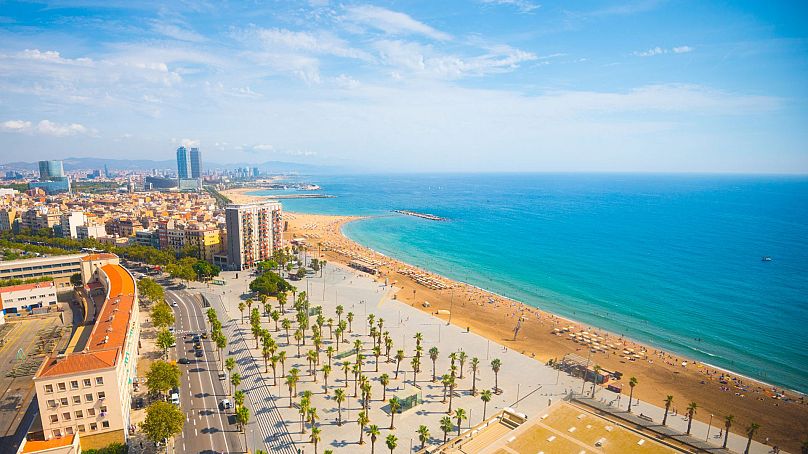Spain has an overtourism problem - but as its beaches slowly disappear, how long will it last?
Blazing heat, prolonged drought and heavy downpours: Spain’s chaotic weather has made tourists think twice about visiting the Mediterranean country in 2024.
With temperatures soaring to 40°C in some places, the lure of sunshine has started to become a deterrent.
The other half of the ‘sol y playa’ tourism model is also at risk as the climate changes - Spain’s beaches are starting to disappear due to rising sea levels and extreme weather.
“We observed that there are many beaches in Spain already affected by erosion, particularly when there are strong waves during winter storms,” says Markus Donat, who co-leads the Climate Variability and Change Group within Barcelona Supercomputing Center’s (BSC) Earth Sciences Department.
During storms at Easter, some Barcelona beaches faced unprecedented sand loss of up to 25 metres in width.
Experts warn that this could become a worrying trend - with potentially devastating impacts on Spain’s thriving tourism industry.
Why are Spain’s beaches disappearing?
Climate change is expected to accelerate the frequency and violence of storms in the future.
“The biggest problem is the greater frequency of maritime storms, whose waves affect the first line of the coast and cause huge damage to beaches and coastal facilities, such as marinas and promenades,” explains Jorge Olcina, professor of geography at the University of Alicante.
This could lead to the beaches shrinking, with a loss of the usable sand available for holidaymakers.
“This problem requires significant economic investments every three or four years to repair the beaches and promenades,” says Jorge.
The Spanish government has said for decades that the country’s coastline suffers from the “generalised process of coastal regression”, and has invested millions into replacing sand on degraded beaches. But in the long term, it warns it will not be possible to keep up with requests from all the municipalities that request such help.
And it’s far from over. “Some conservative models assume that the sea level will rise from half a metre to one metre by the end of the century,” says Markus. “However, these estimates do not include some factors that are not well understood - for example, the impact of the melting ice of the Antarctic. So this could increase predicted increases substantially.”
Which Spanish beaches are most vulnerable to coastal erosion?
Some Spanish regions are more vulnerable than others - among them, Catalonia.
Across northeastern Spain, rising sea levels and winter storms have been eating away at the shoreline. A 2017 report by the regional government suggests that 164 km of the region’s coastline - out of a total of 218 km studied - is at high or very high risk of erosion. Half of the beaches are expected to “deteriorate”.
In Barcelona, whose artificial beaches were installed 30 years ago when the city was hosting the 1992 Olympic Games, the situation is even more critical.
Eight out of nine beaches are at high risk from sea storms. The city already warns that some could disappear entirely.
“Sant Sebastià could almost disappear in the worst-case scenarios, while the others could suffer reductions of between 30 per cent and 46 per cent,” Barcelona City Hall’s 2018-2030 Climate Plan reads.
Of the 700,000 cubic metres of sand sent by the Spanish government to the coast of Barcelona province in 2010, 70 per cent has since disappeared. The city estimates that 30,000 cubic metres of sand are washed away every year.
Looking ahead, Barcelona has gathered a group of experts to study the future of the beaches. In the meantime, the practice of replacing sand is increasingly being seen as a waste of money and damaging to the environment.
How will coastal erosion impact tourism in Spain?
Coastal erosion could have alarming consequences for Spanish tourism, which today accounts for nearly 13 per cent of both GDP and employment in Spain, and is heavily dependent on beaches.
The European Travel Commission (ETC) already reported a 10 per cent decrease in tourist frequency in the Mediterranean in 2023 compared to the previous year, due to climate change and extreme weather events.
And Spain is set to be one of the most severely impacted EU countries going forward, according to a report on the ‘Regional impact of climate change on European tourism demand’ published by the European Commission last year.
In a scenario of 3°C warming from pre-industrial levels, tourist demand could fall by nearly 10 per cent - or more than 15 per cent in a scenario at 4°C, the report states.
Last year, the UN warned that the world is on track for nearly 3°C of warming under current climate plans - far beyond the safe threshold of 1.5°C set in the Paris climate agreement.
But for now, visitor numbers aren’t a concern, as recent overtourism protests from Barcelona to Malaga illustrate.
“Rising sea levels, for now, have no hard effect,” says Jorge. “On the contrary, we are experiencing a boom in the arrival of tourists.”
Spain welcomed a record 53.4 million international tourists up to 31 July - a 12 per cent increase on last year. This pumped €71.1 billion into the economy, according to data from Spain's National Institute of Statistics (INE).
‘The heat is becoming unbearable’
Yet Spain’s tourism industry faces the looming threat of climate change on other fronts.
“The biggest problem remains the constant loss of thermal comfort due to the increase of tropical nights, with temperatures above 20ºC. So the heat is becoming unbearable,” Jorge says.
This could force tourist destinations to make investments in urban design, such as adding more trees and water fountains in the streets, the experts say.
In the meantime, tourists are already starting to turn to the cooler northern regions of the country, long shunned.
Between 2019 and 2023 - a record-hot year in Spain - tourism spending increased the most in the least hot regions of Spain, research from Spanish financial services company CaixaBank, published in January, shows.
It remains to be seen whether the trend will continue.

















